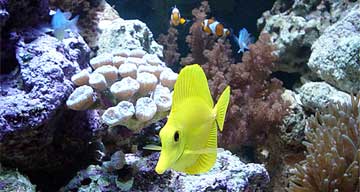Algae and Marine Reef Tanks
A BSD Original Article on the Benefits and Usage of Microalgae to Feed Marine Invertebrates in Reef Tanks

Introduction
Reef tanks can be beautiful and exotic. They can also be expensive and finicky. Owners are constantly monitoring tank parameters, water chemistry, and filtration equipment to care for their prized reef tank specimens.
So why are reef tanks so difficult to maintain? Part of the answer lies in the lack of essential nutrients available to the marine aquarist in the form of natural food. In the ocean environment, there exists a complete, balanced ecosystem, from the smallest microalgae to the largest fish and marine mammals. The ocean consists of different "trophic levels" which are symbiotically linked — and it all begins with single-celled plants.
Advantages of Using Algae:
- Stimulates Feeding: Good nutrition and active feeding are keys to healthy fish larvae and invertebrates.
- Bio-Secure Feed: Algae is certified bacteria- and virus-free.
- High HUFA: Prior to concentrating, the microalgae is cultured in cool temperatures under natural sunlight. This enhances the production of essential fatty acids and marine lipids.
- Enrichment Diet: Excellent feed for raising and bioenriching zooplankton filter-feeders such as Artemia, rotifers, and copepods.
- Convenience: Storage life of the microalgae concentrate is 2 years under refrigeration or sub-zero temperatures.
One of the best solutions for stabilizing your aquarium is to add live microalgae to the system. When live algae is not available, the next best solution is to add our microalgae concentrate to your tank system. By starting at the basis of the marine food chain, you will be able to grow and enrich zooplankton for your fish larvae and invertebrates. Live corals will "go crazy" when marine microalgae is added to the reef aquarium. The addition of microalgae will also enable the culture of more difficult, exotic species such as the "fire scallops."
The Algae species that we recommend for home aquariums are the Nannochloropsis, Isochrysis, and Tetraselmis species. These microalgaes are readily consumed by zooplankton, corals, bivalves, and other filter feeders. The Nannochloropsis microalgae is small (2-4 microns) cell while the Tetraselmis is much larger (16-24 microns) algae. Our "Tahitian Blend" is a combination of these three microalgaes, with inclusion of NatuRose™ (astaxanthin) to enhance the overall health of your prized reef specimens.
Our cryo-preserved Algae species are the next best thing to live algae. Your corals, invertebrates, and other filter-feeders will not only survive, but THRIVE in your reef tank system!
Directions
If this is your first time using Algae, we suggest trying the Tahitian Blend reef formula available in a 12 ml vial or 125 ml squeeze bottle. Since each reef tank system will have a different biomass of filter feeding organisms, you would need to determine your own optimal feeding levels. As a starting guide we recommend the following:
For a 100-gallon reef tank system: Add 5-10 drops of microalgae concentrate to one quart of aquarium seawater (in a separate container). Stir until the microalgae concentrate disperses, and pour into your tank. This feeding should be done at least once per week. Experiment until you determine the best mixture and rate for your system.
Another feeding alternative is to create an "I.V. drip line." Place the quart bottle in a raised position above the tank and slowly drip the microalgae into the tank using a plastic tube with an adjustable clamp.
Note: Algae is "non-living" and will not absorb available nutrients or multiply in your marine aquarium. As with all feeds, it is important not to over-feed your tank system, as excess feed will degrade and increase bacterial problems.
